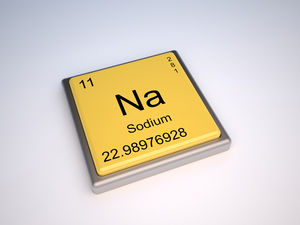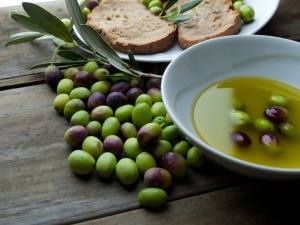Sodium
| See Also | Minerals |
|---|
Sodium is an essential mineral and an electrolyte which needs to be kept in balance with potassium within the body. Both sodium and potassium are involved in the transfer of energy in the body. While potassium is found mostly intracellularly, sodium is found most extracellularly (in the fluids outside of cells). This balance is essential; if this balance didn't exist, too much water would accumulate inside cells causing them to burst. This balance between potassium and sodium is also crucial for maintaining electrical charge within the cell for proper electrical conduction in nerve cells and contraction in muscle cells [1] [2]. Sodium, in proper concentration in the body, also helps to regulate water balance, maintains normal blood pressure, and regulates the body's acid-base balance [3].
Contents
Food Sources
The following is a list of foods which are high in sodium. For a more expansive list on food sources of specific nutrients visit Health Canada's Dietary Reference Intakes for Elements or USDA's National Nutrient Database
- kelp, green olives, salt, dill pickles, soy sauce, ripe olives, sauerkraut, cheddar cheese, scallops, cottage cheese, lobster
When talking about the sodium content in various foods, it is essential to also talk about the potassium-sodium balance. Potassium is found in much greater concentrations than sodium in natural, whole foods whereas when food is processed, this ratio changes. High sodium diets have been linked to cardiovascular disease. This fact may be too narrow of an understanding. It may be more accurate to say that a high sodium, low potassium diet is linked to cardiovascular disease and that a low sodium diet is not always the therapeutic answer. On the flip side, a diet high in potassium and low in sodium may actually be therapeutic especially in the case of high blood pressure [2].
The sodium we obtain in natural foods is often all the body really needs; this makes up about 5% of one's typical sodium intake. 45% of the sodium in a typical American diet comes from processed foods, 45% comes from cooking, and 5% comes from condiments. The sodium in a typical American diet far outweighs one's sodium needs [2]. The average American diet will provide a potassium:sodium ratio of 1:2 when the recommended healthy ratio is actually 5:1. A diet rich in natural foods like fruits and vegetables would provide a ratio of 100:1 which is perhaps, optimal [2]. The following is a list of fruits and vegetables with high potassium:sodium ratios. Choose these foods over processed foods packed with high sodium such as potato chips, pre-packaged meals, and cookies:
- Apples (90:1)
- Bananas (440:1)
- Carrots (75:1)
- Oranges (260:1)
- Potatoes (110:1)
Other food sources include:[4]
- protein sources: Processed meats, such as bacon, sausage, and ham
- vegetables: beets, and celery
- fruit: green olives
- dairy: Milk,
- Other sources include: Worcestershire sauce, soy sauce, onion salt, garlic salt, and bouillon cubes
Uses
- Dehydration: Prolonged loss of body fluids from excessive vomiting, diarrhea, or sweating may put an individual at risk of an electrolyte imbalance and may require supplementation in order to maintain electrolyte balance.
Individuals who may benefit from additional amounts: [3].
- those with Addison's disease, some types of cancers of the adrenal glands, chronic kidney disease
- those who drink excess amounts of water
- those who exercise heavily or sweat excessively due to workload
Deficiency Symptoms
The following are the symptoms associated with sodium deficiency: [3]
- muscle and stomach cramps
- nausea
- fatigue
- mental apathy
- muscle twitching and cramping (usually in legs)
- appetite loss
In severe cases, sodium deficiency can lead to shock resulting from a decrease in blood pressure.
Excess Symptoms
Signs and symptoms of overdose include: [3]
- tissue swelling (edema)
- stupor
- coma
- Hypertension may also be a sign of sodium excess over time.
Assessment Procedure
Lab test to detect deficiency: [3]
Prescribing Considerations
- The recommended dosages varies based on age and health status. To determine what your specific requirements are talk to your naturopathic doctor or other trained medical professional.
- Infant: 120mg (0-6 months); 370mg(7-12 months)
- Child: 1000mg (1-3 years); 1200mg (4-8 years)
- Adolescent: 1500mg (Males and Females, 9-18 years);
- Adult: 1500mg (Males and Females 19-50 years); 1300mg (51-70 years); 1200mg (71+ years)
- Pregnancy and Lactation: 1500mg
Grams of sodium X 2.53 = grams of salt.
The typical American diet provides 3000-12,000mg of sodium a day. The recommended limit is 2400mg. [3].
Safety
- General Adverse Effects: anxiety, confusion, edema, nausea, restlessness, vomiting, weakness
- Contraindications: congestive heart failure, hepatic cirrhosis, hypertension, edema from any cause, a family history of high blood pressure
Drug, Vitamin, Mineral Interactions
Drug, Vitamin and Mineral Interactions include: None are expected. [3]
References
- ↑ Hoffer Abram, Prousky Jonathan (2006) Naturopathic Nutrition, A Guide to Nutrient-Rich Food & Nutritional Supplements for Optimum Health, CCNM Press
- ↑ 2.0 2.1 2.2 2.3 Murray Michael T (2005) Encyclopedia of Nutritional Supplements, The Essential Guide for Improving Your Health Naturally, Prima Publishing
- ↑ 3.0 3.1 3.2 3.3 3.4 3.5 3.6 Griffith Winter (2000) Vitamins, Herbs, Minerals & Supplements: The Complete Guide, MJF Books.
- ↑ Medlineplus [1]

